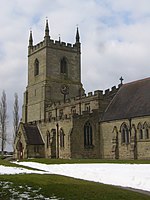Shackerstone railway station
Former London and North Western Railway stationsFormer Midland Railway stationsGrade II listed buildings in LeicestershireGrade II listed railway stationsHeritage railway stations in Leicestershire ... and 8 more
John Holloway Sanders railway stationsMuseums in LeicestershirePages with no open date in Infobox stationRailway museums in EnglandRailway stations in Great Britain closed in 1931Railway stations in Great Britain opened in 1873ShackerstoneUse British English from February 2017
Shackerstone railway station is a preserved railway station and heritage museum in Leicestershire, Central England. It is the terminus and the headquarters of the heritage Battlefield Line Railway, with the Shackerstone Railwayana Museum, tea room, shop, loco shed and main rolling stock located here. The Ashby Canal is nearby.
Excerpt from the Wikipedia article Shackerstone railway station (License: CC BY-SA 3.0, Authors).Shackerstone railway station
Station Road, Hinckley and Bosworth
Geographical coordinates (GPS) Address External links Nearby Places Show on map
Geographical coordinates (GPS)
| Latitude | Longitude |
|---|---|
| N 52.6555 ° | E -1.4413 ° |
Address
Shackerstone
Station Road
CV13 6NW Hinckley and Bosworth
England, United Kingdom
Open on Google Maps










